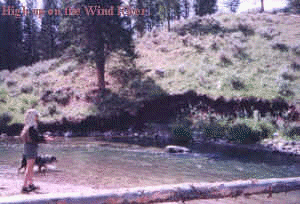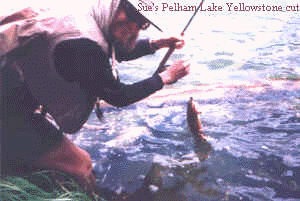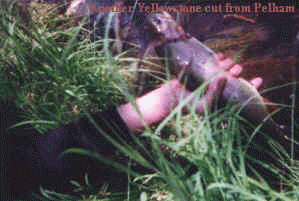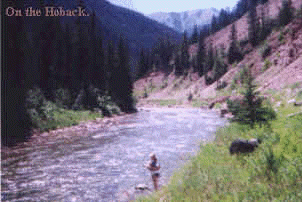 A quick follow
up retrospective on the cutthroat trip including a few extra photos.
A quick follow
up retrospective on the cutthroat trip including a few extra photos. A quick follow
up retrospective on the cutthroat trip including a few extra photos.
A quick follow
up retrospective on the cutthroat trip including a few extra photos.
Thinking back on the trip we probably made a mistake by not trying to glean more local knowledge about trout locations and stream accessibility - particularly during the hot, dry period of the summer when we were forced to visit here.
The Northwest part of the state's larger rivers and lakes are much easier to fish and
contain larger populations of the indigenous species than does the Southwest corner where
both the Bonneville and Colorado strains exist in fewer numbers and in smaller, more
difficult to access drainage's. We remain a bit annoyed at some of the descriptions
contained in the "Fly Fishing in Wyoming" book and would question the accuracy
of certain statements related to the quality of and fishability of a number of streams and
rivers.
Because of the relatively poor water quality in the Southwest part of the state, it probably is almost essential for private individuals not using local outfitters as guides to travel there in at least a high bed pickup truck and even more preferably, a four wheel drive vehicle. We don't have the luxury of those conveyances and assume we're going to have some difficulty accessing the headwater areas most likely to contain relatively decent numbers of fish when we revisit the region this fall.
From an overall tackle standpoint the standard fly patterns we use commonly here in Colorado serve equally well throughout the variety of waters we visited in Wyoming. The only exception might be a need to add localized nymph designs since we had very limited success on our own subsurface imitations on the Wyoming streams. Tippets worked fine at either 4X or 5X - or 3X for larger hoppers & wooly buggers, and we now use fluorocarbon material exclusively.
 Nowhere did we need
anything heavier than our 5 or 6 weight rods. Both Sue & I have fast tip
versions for larger, windier waters, and shorter full flex rods for the smallest streams.
Nowhere did we need
anything heavier than our 5 or 6 weight rods. Both Sue & I have fast tip
versions for larger, windier waters, and shorter full flex rods for the smallest streams.
We were able to wet wade exclusively on the trip & our conventional felt soled sandals worked fine on all the wet stream surfaces we encountered. Bugs were not a major problem anywhere. We did run into a few mosquitoes in some of the bog/wetland areas, but they were not a major issue like one hears horror stories about in the upper Wind River lakes region.
 Without having to
physically drive to Yellowstone Park our favorite spot for that particular species of
cutthroat was definitely Pelham Lake just off the upper Wind River highway. Not only
are the sizes excellent, but our success under very difficult weather conditions suggest
that the catch rate could be quite high on a less windy day on surface flies.
Without having to
physically drive to Yellowstone Park our favorite spot for that particular species of
cutthroat was definitely Pelham Lake just off the upper Wind River highway. Not only
are the sizes excellent, but our success under very difficult weather conditions suggest
that the catch rate could be quite high on a less windy day on surface flies.
The Hoback is probably the easiest place to catch quantities of finespotted cut's.
Populations are high even though sizes (at least where we were fishing) were not
particularly large.
For Bonneville's Sue had her success on the very upper part of the Smith Fork. We suspect that larger quantities of better fish might be had lower down on this stream, but access in a conventional vehicle is almost impossible from the headwater area.
Given our time constraints and had we figured it out quicker, I suspect we'd have caught decent quantities of Colorado cut's on upper La Barge Creek. But as the road surface there is very unpleasant, there's little likelihood we'll return to this stream in the future, leaving us with something of a mystery as to where we'll be successful on this particular strain in the future.